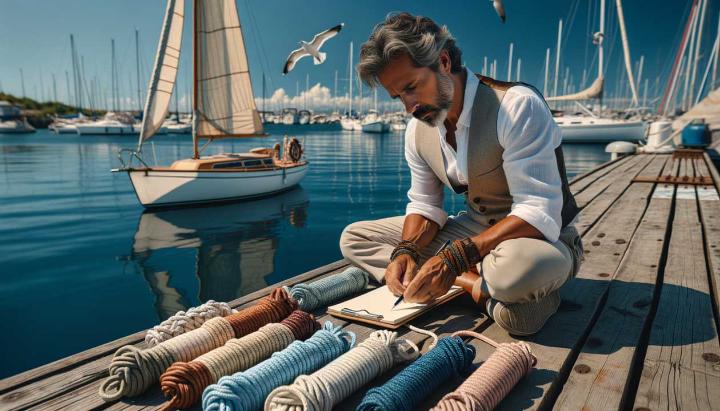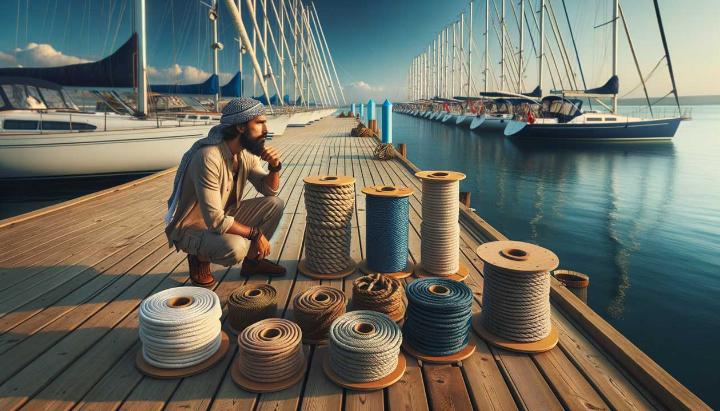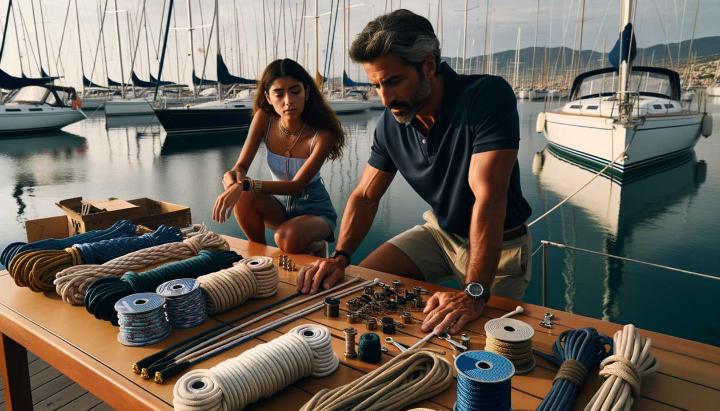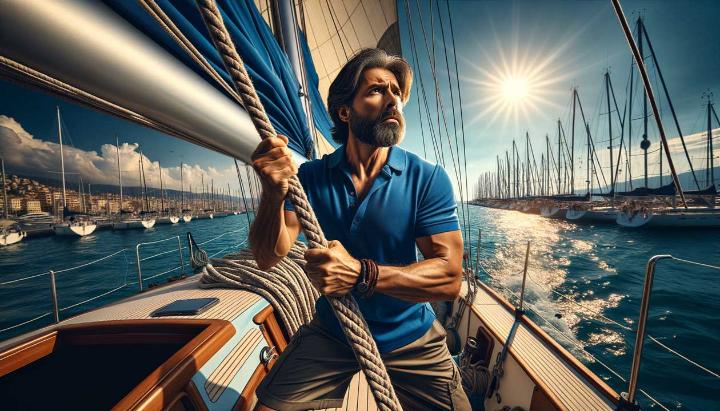Imagine you're out on the open waters, the salty breeze whipping through your hair as you expertly maneuver your sailboat across the waves. But as you attempt to hoist the mainsail, you notice something's not quite right – the rope pulley system seems a bit sluggish, with the lines rubbing and catching against the hardware.
In that moment, the importance of selecting the right marine rope pulley becomes crystal clear. It's not just about aesthetics or convenience; it's about ensuring the safe and efficient operation of your vessel, allowing you to harness the power of the wind and experience the thrill of sailing to the fullest.
Whether you're a seasoned seafarer or a newcomer to the world of sailing, navigating the vast array of rope pulley options can be a daunting task. From the intricate construction methods to the diverse range of materials, each choice has the potential to significantly impact your boat's performance and your overall sailing experience.
That's why, in this comprehensive guide, we'll dive deep into the world of boat rope pulleys, exploring the nuances that separate the mediocre from the exceptional. We'll unravel the mysteries of rope types, materials, and constructions, equipping you with the knowledge to make informed decisions tailored to your specific sailing needs.
So, secure your lines, hoist your sails, and join us on this journey as we unlock the secrets to choosing the best marine rope pulley for your boat. Get ready to experience sailing like never before, with optimized performance, enhanced safety, and a newfound appreciation for the intricate details that make all the difference on the open waters.
Understanding the Different Types of Sailboat Ropes
When it comes to sailing, choosing the right rope is crucial for ensuring a safe and enjoyable experience on the water. Sailboat ropes come in various types, each with its own unique characteristics and applications. Understanding these differences can help you make an informed decision that meets your specific sailing needs.
Twisted and Braided Ropes: Exploring the Differences
Sailboat ropes can be broadly categorized into two main types: twisted and braided ropes.
- Twisted ropes are constructed by twisting individual strands together, creating a rope with a traditional, round shape. These ropes can be further divided into three-strand and braided constructions. Three-strand twisted ropes are known for their classic appearance and good abrasion resistance, making them suitable for anchor lines and mooring applications.
- Braided ropes, on the other hand, are formed by interweaving multiple strands in a circular pattern. This construction method results in a rope that is more flexible and has a higher strength-to-weight ratio compared to twisted ropes. Braided ropes come in single-braid and double-braid variants, with the latter offering more strength and less stretch, making them ideal for running rigging, halyards, and control lines.
Whether you choose a twisted or braided rope, consider factors such as strength, stretch, and abrasion resistance to ensure it meets your sailing requirements.
Materials Used in Sailboat Ropes: From Nylon to Dyneema
In addition to the construction method, the material used in sailboat ropes plays a vital role in their performance. Some of the most commonly used materials include:
- Nylon is a popular choice for running rigging ropes due to its excellent strength, elasticity, and resistance to UV rays and chemicals. However, it can be susceptible to abrasion and creep (gradual stretching under load).
- Polyester ropes offer low stretch and excellent durability, making them suitable for cruising applications where minimal elongation is desired. They are also resistant to UV rays and chemicals, but may not be as elastic as nylon ropes.
- Dyneema, also known as high-modulus polyethylene (HMPE), is a lightweight yet incredibly strong material that has become a favorite among racing sailors. Dyneema ropes offer minimal stretch, high strength-to-weight ratio, and excellent abrasion resistance, making them ideal for performance-oriented sailing.
When choosing a rope material, consider factors such as strength requirements, UV exposure, chemical resistance, and stretch characteristics to ensure optimal performance in your sailing conditions.

Selecting the right type and material for your sailboat ropes is crucial for ensuring a safe and enjoyable sailing experience. By understanding the differences between twisted and braided ropes, as well as the unique characteristics of various rope materials, you can make an informed decision that aligns with your specific sailing requirements.
Key Factors to Consider When Choosing Sailboat Rope Materials
As a passionate sailor myself, I know firsthand how crucial it is to select the right rope materials for your sailboat. The ropes you choose can make or break your sailing adventures, impacting everything from performance to safety. With so many options available, it can be daunting to decide which materials are best suited for your unique needs.
Stretch, Cost, Weight, and Handling
- Stretch is a critical factor to consider when selecting rope materials. Some materials, like nylon, offer more elasticity, which can be advantageous for absorbing shock loads. Others, like polyester and Dyneema, provide minimal stretch, making them ideal for applications where precise control and minimal elongation are essential.
- Cost is another important consideration, especially if you're sailing on a budget. While high-performance materials like Dyneema offer exceptional strength and durability, they can be more expensive than traditional options like nylon or polyester. Striking the right balance between cost and performance is key.
- Weight is a factor that can impact both handling and performance. Lighter ropes are generally easier to manage and can contribute to better sailing efficiency, but they may sacrifice strength or durability. Heavier ropes, on the other hand, might be more challenging to handle but offer superior strength and resistance to abrasion.
- Ease of handling is something you'll want to consider, especially for lines that require frequent adjustment or handling. Some materials are more supple and easier to grip, while others may be stiffer or more prone to kinking, which can make them more challenging to work with on the water.
Rope Core and Cover Materials
When selecting sailboat ropes, it's essential to understand the different core and cover materials and how they contribute to overall performance. The core is the heart of the rope, providing the majority of its strength, while the cover offers protection and additional properties like UV resistance or abrasion resistance.
- Nylon is a popular choice for both cores and covers. It offers excellent strength, elasticity, and resistance to UV rays and chemicals. However, it can be susceptible to abrasion, making it essential to choose appropriate nylon ropes for your specific applications.
- Polyester is renowned for its durability and low stretch, making it an excellent choice for cores in running rigging or anchor lines where minimal elongation is desired. Its cover is also highly resistant to UV rays and chemicals, ensuring long-lasting performance.
- Dyneema, or high-modulus polyethylene (HMPE), is a lightweight yet incredibly strong material often used in high-performance ropes. Its low stretch and excellent abrasion resistance make it a top choice for racing applications or situations where maximum strength and minimal elongation are critical.
- Blended cores and specialized constructions like Viper and Nexus Pro offer unique combinations of materials and construction methods, catering to specific sailing needs. These ropes can provide tailored performance characteristics, such as enhanced grip, improved flexibility, or specialized coatings for added protection.
Selecting the right rope materials is an art form, and understanding the nuances of each option's properties will empower you to make informed decisions that align with your sailing goals and preferences.

Whether you're a seasoned sailor or just starting your adventures on the water, taking the time to understand the intricacies of rope materials can make a world of difference in your sailing experience. By carefully considering factors like stretch, cost, weight, and ease of handling, and selecting the appropriate core and cover materials, you'll be well on your way to equipping your sailboat with the perfect ropes for your unique needs.
Factors for Choosing the Right Rope Construction
When it comes to selecting the perfect rope for your application, the construction method plays a pivotal role. Whether you're outfitting your sailboat, rigging up a climbing setup, or preparing for an industrial lifting operation, understanding the nuances of different rope constructions can mean the difference between success and potential failure.
Application and Usage Requirements
The intended application and usage requirements should be the first consideration when choosing a rope construction. Different scenarios demand varying levels of strength, flexibility, abrasion resistance, and fatigue resistance.
- Marine applications, such as sailing or boating, often require ropes that can withstand constant exposure to water, UV rays, and saltwater environments. Braided constructions like double-braided ropes or kernmantle ropes are popular choices for their excellent flexibility, low stretch, and resistance to abrasion.
- Outdoor recreation, like climbing or camping, necessitates ropes that prioritize strength, durability, and resistance to wear and tear from rough surfaces. Twisted or three-strand ropes are favored for their rugged construction and resistance to abrasion. For more details on versatile and eco-friendly options, check out Discover the Versatility of Synthetic Jute Rope and Jute Cord.
- Industrial lifting and rigging demand ropes with exceptional strength and minimal stretch. Double-braided ropes or parallel core ropes are often employed for their high load capacities and resistance to crushing and abrasion.
By carefully considering the specific demands of your application, you can narrow down the suitable rope constructions, ensuring optimal performance and longevity.

Rope Strength and Load Capacity
Strength and load capacity are critical factors when selecting a rope construction, especially for applications involving heavy loads or potential shock loading. Different constructions offer varying levels of strength and load-bearing capabilities.
- Double-braided ropes are renowned for their exceptional strength and resistance to stretch under load. Their tightly woven construction and balanced load distribution make them ideal for applications requiring high tensile strength and minimal elongation. To learn more about the versatility of high-performance ropes, visit Discover the Versatility of Manila Rope: A Quick Guide.
- Three-strand twisted ropes provide robust strength and good resistance to abrasion, making them suitable for anchoring, mooring, and general utility applications where moderate load capacities are required. For more insights on twisted ropes, see The Advantages of Twisted Rope You Shouldn't Miss.
- Kernmantle ropes, with their tightly braided sheath and high-strength core, offer an optimal balance of strength and flexibility, catering to applications like climbing or rescue operations where both load capacity and maneuverability are essential.
Always consult the manufacturer's specifications and load ratings to ensure that the rope construction you choose can safely handle the expected loads and potential shock scenarios.
Abrasion and Fatigue Resistance
In many applications, ropes are subject to constant abrasion and fatigue, which can compromise their integrity and lifespan. Selecting a rope construction that can withstand these challenges is crucial for ensuring safety and longevity.
- Abrasion resistance is influenced by factors like surface texture and flexibility. Three-strand twisted ropes and double-braided ropes generally offer excellent abrasion resistance due to their tight constructions and balanced load distribution, making them ideal for applications involving contact with rough surfaces or frequent bending.
- Fatigue resistance is critical for applications involving cyclic loading or repeated bending and flexing. Double-braided ropes and kernmantle ropes are known for their superior resistance to fatigue, thanks to their balanced load distribution and ability to maintain their structural integrity under repeated stress.
By considering the specific environmental conditions and potential sources of abrasion and fatigue, you can select a rope construction that can withstand these challenges, ensuring a longer service life and enhanced safety.
Remember, choosing the right rope construction is not a one-size-fits-all solution. It requires a careful evaluation of your application's unique demands, load requirements, and environmental factors. By taking the time to understand the intricacies of different rope constructions and their respective strengths and limitations, you can make an informed decision that maximizes performance, safety, and longevity.
Matching Rope Properties to Sailing Scenarios
As any experienced sailor will tell you, choosing the right rope for your sailing needs is an art form. It's not just about picking a sturdy line and calling it a day; it's about carefully matching the rope's unique properties to the specific scenario you'll be facing on the water.
Picture this: You're out on a gorgeous summer day, the wind gently filling your sails as you glide across the glistening waves. But wait, something's not quite right – your jib sheet is stretching out like an overcooked spaghetti noodle, causing your sail to sag and lose that crisp, efficient shape. That's the result of using the wrong rope for the job.
On the flip side, imagine trying to hoist your mainsail using a rope that's as stiff as a steel rod. Not only will it be a frustrating wrestling match, but you also run the risk of damaging your equipment or, worse, injuring yourself.

That's why understanding rope properties and how they relate to different sailing scenarios is so crucial. It's the key to optimizing your boat's performance, ensuring your safety, and making the most of your time on the water.
Understanding Rope Properties
Before we dive into specific sailing scenarios, let's take a moment to understand the fundamental properties that make each rope unique:
- Strength – This one's pretty self-explanatory; it determines how much load a rope can handle before it breaks. But strength isn't just about brute force; it's also about maintaining that strength under different conditions, like exposure to sunlight, saltwater, and abrasion.
- Stretch – Some ropes stretch like a rubber band, while others are as taut as a bowstring. This property is all about elasticity and how much the rope will elongate under tension. Too much stretch, and you lose control; too little, and you risk snapping under sudden loads.
- Abrasion Resistance – Let's face it; ropes take a beating on a boat. They rub against metal fittings, scrape across decks, and endure all sorts of wear and tear. Abrasion resistance is what determines how well a rope can handle that rough treatment without fraying or breaking down prematurely.
- UV Resistance – The sun's rays can be brutal on synthetic materials, causing them to weaken and break down over time. UV resistance is a rope's ability to withstand that solar onslaught, ensuring it maintains its strength and integrity for years to come.
Understanding these properties and how they vary between different rope materials (like nylon, polyester, and Dyneema) is the first step in matching the right rope to the right sailing scenario.
Common Sailing Scenarios and Rope Requirements
Now that we've covered the basics, let's dive into some common sailing scenarios and the rope properties that are most important for each one:
- Racing Applications – When every second counts, you need ropes that are lightweight, offer minimal stretch, and boast exceptional strength. Dyneema or high-performance polyester ropes are often the go-to choices for racers, as they provide the perfect balance of low weight, low stretch, and high tensile strength. For more information on the benefits of these materials, visit Discover the Benefits of Nylon and Dyneema Cordage.
- Cruising Applications – For more leisurely sailing adventures, durability, UV resistance, and ease of handling are key. Nylon or double-braided polyester ropes are popular options, as they offer excellent abrasion resistance, UV protection, and a comfortable grip, even when wet.
- Anchoring and Mooring – When it comes to securing your boat, you need ropes that can handle heavy loads, resist abrasion from rough surfaces, and maintain minimal stretch over time. Three-strand nylon or polyester ropes are often the choice for anchor lines and docking lines, as they offer exceptional strength, good abrasion resistance, and minimal elongation under constant tension.
- Rope Pulley Systems – For lines that run through pulleys, blocks, or other hardware, you'll want ropes that are lightweight, have a low-friction coating, and are compatible with the size of your equipment. Double-braided polyester or specialized rope pulley lines are ideal, as they offer a smooth, low-friction surface that glides effortlessly through your boat's rigging.
Of course, these are just general guidelines, and your specific sailing needs may vary. But by understanding the key rope properties and how they relate to different scenarios, you'll be better equipped to make informed choices that maximize your boat's performance and keep you safe on the water.
Fill in the form above to get expert advice and find the right boat rope pulley for your specific needs. Enhance your sailing experience with the perfect rope solutions tailored to your requirements.